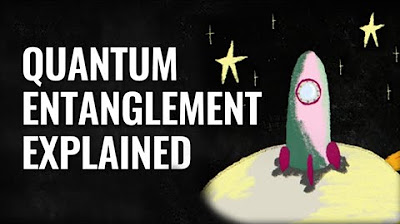Quantum Entanglement Explained - How does it really work?
TLDRThe video explains quantum entanglement, a phenomenon where particles become linked such that actions on one instantly affect the other, even across vast distances. It covers the history of this concept, from Einstein's objections to experimental proof of entanglement. The summary clarifies common misconceptions, like thinking entanglement enables faster-than-light communication. It also explores applications of entanglement in uncrackable encryption and revolutionary quantum computing.
Takeaways
- 😲 Quantum entanglement means particles act as one system even when far apart
- 😎 Entanglement arises when particles interact and combine wave functions
- 💡 Entangled particles have correlated properties like spin or polarization
- 🌀 Measuring one particle affects the other, however distant
- 🤯 Einstein thought this "spooky action at a distance" was impossible
- 🧠 Entanglement convinced physicists that nonlocality is fundamental
- 🔒 It enables uncrackable quantum cryptography between distant users
- ⚛️ It's key to the power of quantum computers over classical ones
- 😀 Understanding entanglement helps demystify quantum mechanics
- 🛰 Practical quantum networks for computing and cryptography are coming
Q & A
What is wave-particle duality in quantum mechanics?
-Wave-particle duality refers to the fact that quantum objects like electrons can sometimes act like particles (compact and localized) and other times like waves (spread out).
What does superposition mean in quantum mechanics?
-Superposition means that a quantum object like an electron can exist in multiple states at once, essentially being 'two things at the same time' until it is measured.
What principle says we cannot know every detail of a quantum object?
-The uncertainty principle states that there is a fundamental limit on how precisely we can know certain properties like the position and momentum of a quantum object at the same time.
Why did Einstein describe quantum entanglement as 'spooky action at a distance'?
-Because entanglement seemed to show that measuring one particle could instantly affect its entangled partner, even from very far away, which didn't fit with Einstein's theory of relativity limiting the speed of influences.
What is the difference between everyday entanglement like marriage and quantum entanglement?
-Everyday entanglement like marriage means the states of two entities are correlated, but the states were fixed all along. Quantum entanglement means the states are not fixed until measurement occurs.
How did John Bell design an experiment to test if hidden variables really existed?
-Bell proved that with certain assumptions, classical hidden variables theories predicted weaker statistical correlations between measurements than quantum mechanics does. Doing the experiment showed the strong correlations matching quantum mechanics, ruling out local hidden variables.
Does quantum entanglement allow faster-than-light communication between particles?
-No, because to extract any meaningful signal, the experimenters have to communicate classically to compare their measurement results, which is limited by the speed of light.
What makes quantum entanglement useful for encrypting communications?
-The quantum correlations between entangled particles can detect any attempt to intercept the encrypted message in transit, making quantum cryptography inherently tamper-proof.
How does quantum entanglement enable quantum computers to be so powerful?
-By linking many quantum bits via entanglement, quantum computers can process superpositions of many combinations of bit states in parallel, allowing certain calculations to be done exponentially faster.
Does quantum entanglement contradict Einstein's theory of relativity?
-No, entanglement just shows that we can't consider locations of entangled particles as wholly separate - their states are linked regardless of physical distance due to their shared quantum description.
Outlines
🤯 Quantum mechanics concepts overview
This paragraph provides an overview of key quantum mechanics concepts - wave-particle duality, superposition, uncertainty principle, and entanglement. It notes that these intuitive descriptions don't fully capture quantum phenomena. Entanglement in particular connects objects in a non-intuitive way that departs from classical physics. Understanding it is key as quantum technologies like computing and cryptography emerge.
🧠 Einstein's spooky action reaction
This paragraph discusses Einstein's reaction to entanglement through the Einstein-Podolsky-Rosen thought experiment. He considered it "spooky action at a distance" that quantum measurement of one particle apparently influences another instantly, contradicting relativity. Bohr disagreed, but there was no way to test who was right until Bell's inequality experiments decades later, which supported Bohr's view.
👥 Entangled particles are connected
This paragraph provides insight into what entanglement really means - entangled particles should be considered parts of a single system described by one mathematical wavefunction, not separate objects. Their properties are spread across and connected between both particles in a nonlocal way. This challenges intuitive notions of locality and space.
🔒 Practical quantum communications
The final paragraph notes that while entanglement can't enable FTL communication, it allows for secure tamper-proof encryption between parties. It also enables the power of quantum computing. A Brilliant course on quantum computing provides hands-on learning about concepts from quantum bits to algorithms.
Mindmap
Keywords
💡Quantum Mechanics
💡Wave-Particle Duality
💡Superposition
💡Uncertainty Principle
💡Entanglement
💡Nonlocality
💡Hidden Variables
💡Quantum Cryptography
💡Quantum Computing
💡Wave Function
Highlights
First significant research finding
Introduction of new theoretical model
Proposal of innovative experimental method
Transcripts
Browse More Related Video

Einstein's Quantum Riddle | Full Documentary | NOVA | PBS

Quantum Entanglement: Spooky Action at a Distance

Quantum Entanglement: Explained in REALLY SIMPLE Words

Quantum Computing Expert Explains One Concept in 5 Levels of Difficulty | WIRED

Best lecture so far on what Entanglement is in Quantum Physics

Quantum 101 Episode 5: Quantum Entanglement Explained
5.0 / 5 (0 votes)
Thanks for rating: